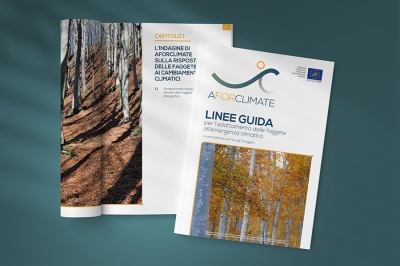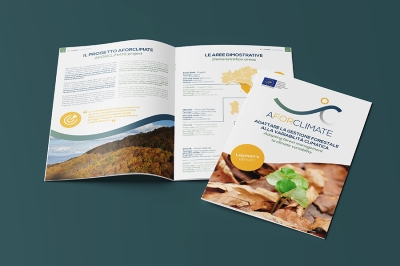
AIMS OF THE PROJECT
The LIFE AForClimate project aims to provide concrete options to achieve solutions in forestry and forest planning that are effective in adapting to climate change. The objective is to adapt the management of the beech forests (Fagus sylvatica) to the variability of climate and its changes during time by programming forest management and interventions on the basis of climate cycles.
In particular, AForClimate aims to improve the knowledge of climate/tree growth relationships as a ground on which to develop actions adaptive to climate variability and trends. This can be done through the creation of models that include climate variability at the level of high geographical detail, which is necessary to develop and apply calendars and practices for sustainable forestry interventions.
AForClimate builds a model to allow the collection of a greater quantity of wood mass (from 5-7% to 15-20%) during periods of favourable climatic conditions. At the same time, this approach would stimulate the increase of CO2 sequestered by both storage and higher rate of growth. This would preserve the productive capacity of the forest and mitigate the impacts of climate changes on forest resilience and productivity .
The project also envisages a monitoring mechanism that measures the effects of the model on forest management and assesses its impacts in terms of production capacity, regeneration, and biodiversity by the end of the implementation period. In fact, AForClimate includes the entire beech ecosystem and considers its components as essential for appropriate forest management.

ACTIONS
The AForClimate Project deploys 17 Actions subdivided into 5 sub-Actions:
Preparatory actions (Action A)
-
A1 / Definition of reactivity thresholds in tree growth by sampling and dendroclimatological analysis;
-
A2 / Detailed design of a climate monitoring network and collection of geomorphological information.
Implementation actions (C Actions)
-
C1 / Application of different types of silvicultural interventions for forest production;
- C2 / Application of different types of silvicultural interventions for forest regeneration;
-
C3 / Development of forest management guidelines through the creation of a national technical panel with stakeholders in relation to the topics of Climate Change;
-
C4 / Application of the guidelines through a Prototype of DSS for forest planning and management;
-
C5 / Application of planning models in the forest management prototype;
-
C6 / Plan for the transfer of results and project protocols.
Monitoring actions (Actions D)
-
D1 / Validation of the system through analysis of the effective reactivity of the forest in relation to different types of intervention.
Communication actions (E actions)
-
E1 / Workshop and final conference;
-
E2 / Notice-board;
-
E3 / Website of the project;
-
E4 / Publication of the guidelines, video documentary and Layman's report.
Project management actions (Actions F)
-
F1 / Management and monitoring of the project;
-
F2 / Building a network;
-
F3 / After-LIFE Action Plan
-
F4 / Audit

DEMONSTRATION AREAS
The demonstration areas of the AForClimate project are located in beech forests in 3 different regions, respectively Tuscany, Molise, and Sicily.
The suitable areas of intervention and monitoring in each forest complex will be identified in order to cover the range of climatic extremes at best. The following site conditions will be included:
- high elevation belt, northern exposure;
- high elevation belt, southern exposure;
- low elevation belt, northern exposure; and
- low elevation belt, southern exposure.

PARTNERSHIP
The AForClimate Project is equipped with a well-structured and integrated partnership, which is formed by eight subjects subdivided in research bodies, local authorities, and private companies.
Coordinating beneficiary
- CREA - Council for Agricultural Research and Economics; Research centre for Forestry and Wood
More info >>>
Scientific partners
- University of Palermo, Department of Agricultural and Forestry Sciences
More info >>> - University of Molise, Department of Biosciences and Territory
More info >>>
Local partners
- Sicilian Region, Regional Department of Agriculture, Rural Development, and Mediterranean Fisheries
More info >>> - Molise region
More info >>> - Mountain Union of the Municipalities of Mugello (U.C. Mugello)
More info >>>
Technical responsible partner
- D.R.E.AM. Italy, a cooperative forestry company
More info >>>
Communication responsible partner
- Compagnia delle Foreste
More info >>>

WHAT IS LIFE
LIFE is a Program introduced by the European Union in 1992 where projects on environmental issues proposed by the member countries are co-financed. The objective is to provide specific support for the development and implementation of the Community environmental policy and legislation, and in particular to pursue the objectives of the Sixth Community Environment Action Program. Funded projects can be proposed by public or private operators, bodies or institutions.
For the 2014-2020 period, the LIFE Program has a total budget of 3.4 billion euro to finance projects aimed at environmental protection, and adaptation and climate change mitigation.
Through the "calls" that are annually proposed by the European Commission, it is possible to submit projects in one of the 4 current sections of LIFE:
- Nature and biodiversity
- Environment
- Climate action
- Information and governance
To find out more about the LIFE Program, download information material and forms, check the deadlines of the "calls", and discover other LIFE projects, you can visit the dedicated website of the European Commission - Environment (in English): https://cinea.ec.europa.eu/life_en appropriate forest management.
Ultime notizie









